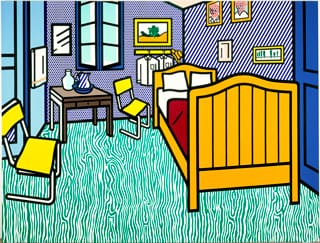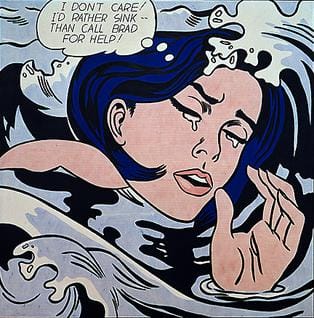As a lover of art, I have always been fascinated by the works of Roy Lichtenstein. Known for his unique interpretation of popular culture and comic book style, Lichtenstein has become an icon of the Pop Art movement. In this comprehensive guide, I will delve into his biography, art style, iconic works, impact on popular culture, exhibitions and museums showcasing his art, legacy, and investing in his art.
Introduction to Roy Lichtenstein and his influence on Pop Art
Roy Lichtenstein, born in 1923 in New York City, was one of the most influential artists of the 20th century. He became a leading figure in the Pop Art movement, which emerged in the 1950s and 1960s as a response to the rise of consumer culture and mass media. Pop Art aimed to blur the boundaries between high and low culture, often using commercial imagery and techniques to create art that was accessible to the masses.
Lichtenstein’s art was heavily influenced by comic books, which he began collecting as a child. He found inspiration in the bold lines, bright colors, and dramatic compositions of comic book panels, which he would later use to create his own unique style. Lichtenstein’s works often featured enlarged and cropped images of comic book characters, speech bubbles, and onomatopoeic words, creating a sense of movement and drama that captivated audiences.
Biography and early life

Roy Lichtenstein was born in a Jewish family in New York City. His father was a real estate broker, and his mother was a homemaker. Lichtenstein showed an early interest in art, attending art classes at the Art Students League of New York as a teenager. He went on to study at Ohio State University, where he earned a degree in Fine Arts.
After serving in World War II, Lichtenstein returned to Ohio State University to teach, where he met his future wife, Isabel Wilson. They moved to Cleveland, where Lichtenstein worked as a commercial artist and began experimenting with his own art style. In 1957, Lichtenstein moved to New York City, where he began teaching at Rutgers University and became part of the thriving art scene.
Lichtenstein’s unique art style and techniques
Lichtenstein’s art style was characterized by his use of bold lines, bright colors, and Ben-Day dots, a printing technique used in comic books to create shading and texture. He often used stencils and projected images to create his works, which were typically large-scale paintings on canvas. Lichtenstein’s technique was meticulous, with each element carefully planned and executed to create a sense of precision and perfection.
One of Lichtenstein’s most famous techniques was his use of the Benday dot, a small colored dot that he used to create shading and texture in his works. This technique, inspired by commercial printing, created a sense of depth and texture that was unique to Lichtenstein’s art. He also became known for his use of speech bubbles and onomatopoeic words in his works, which added a sense of drama and movement to the images.
Iconic works of Roy Lichtenstein
Lichtenstein’s most famous works are his comic book-inspired paintings, which feature enlarged and cropped images of comic book characters and scenes. One of his most iconic works is “Whaam!”, a large-scale painting that depicts a fighter plane being hit by a missile. The painting is based on a comic book panel and features Lichtenstein’s signature use of speech bubbles and onomatopoeic words.
Another famous work of Lichtenstein is “Drowning Girl,” a painting that depicts a woman drowning in water. The painting is based on a comic book panel and features Lichtenstein’s signature use of Benday dots and speech bubbles. The painting has become a symbol of Pop Art, with its bold colors and dramatic composition.
Analysis of Lichtenstein’s most famous pieces

Lichtenstein’s most famous pieces are notable for their use of commercial imagery and techniques, as well as their sense of drama and movement. His works often feature cropped and enlarged images of comic book characters, which create a sense of tension and energy. Lichtenstein’s use of Benday dots also adds texture and depth to the images, creating a sense of realism that contrasts with the flatness of the comic book style.
The use of speech bubbles and onomatopoeic words in Lichtenstein’s works adds a sense of humor and irony, as well as a commentary on the role of language in popular culture. By isolating and enlarging these elements, Lichtenstein draws attention to the ways in which language shapes our understanding of the world.
Lichtenstein’s impact on popular culture
Lichtenstein’s art has had a profound impact on popular culture, influencing everything from fashion to music to film. His use of commercial imagery and techniques has been adopted by countless artists and designers, who continue to draw inspiration from his works.
Lichtenstein’s art has also been featured in films such as “Pulp Fiction” and “The Royal Tenenbaums,” as well as in music videos by artists such as Madonna and David Bowie. His influence can also be seen in the work of contemporary artists such as Jeff Koons and Damien Hirst, who continue to push the boundaries of Pop Art.
Exhibitions and museums featuring Lichtenstein’s work
Lichtenstein’s art is featured in many museums and galleries around the world, including the Museum of Modern Art in New York City, the Tate Modern in London, and the Centre Pompidou in Paris. These institutions showcase Lichtenstein’s iconic works, as well as lesser-known pieces, providing audiences with a comprehensive view of his career.
In addition to these museums, there are also many exhibitions dedicated solely to Lichtenstein’s art. These exhibitions offer a deeper understanding of his work and provide insights into his creative process and influences.
Roy Lichtenstein’s legacy and influence on contemporary art
Roy Lichtenstein’s legacy is one of innovation and creativity. His art has had a profound impact on popular culture and has inspired countless artists and designers. His use of commercial imagery and techniques, as well as his sense of humor and irony, continue to shape the art world today.
Lichtenstein’s influence can be seen in the work of contemporary artists such as Jeff Koons and Damien Hirst, who continue to push the boundaries of Pop Art. His legacy is also evident in the countless exhibitions and museums dedicated to his art, which continue to attract audiences from around the world.
Collecting and investing in Lichtenstein’s art
Roy Lichtenstein’s art is highly sought after by collectors and investors alike. His iconic works, such as “Whaam!” and “Drowning Girl,” have sold for millions of dollars at auction, making them valuable investments for those who appreciate his unique style and contribution to the art world.
Collecting Lichtenstein’s art can be a rewarding experience, both financially and artistically. His works continue to captivate audiences and inspire new generations of artists, ensuring that his legacy will endure for years to come.
Roy Lichtenstein was a master of Pop Art, pushing the boundaries of traditional art forms to create works that were both innovative and accessible. His use of commercial imagery and techniques, as well as his sense of humor and irony, continue to inspire artists and designers today.
Through his iconic works and exhibitions dedicated to his art, Lichtenstein’s legacy lives on, ensuring that his contributions to the art world will be remembered for generations to come. Whether you are a collector, an artist, or simply a lover of art, Roy Lichtenstein’s art is sure to captivate and inspire.









